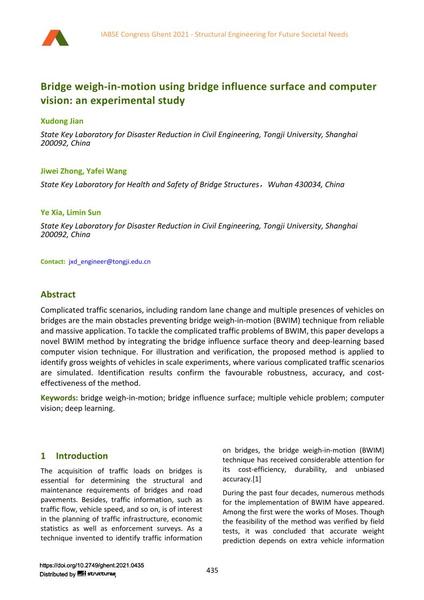Bridge weigh-in-motion using bridge influence surface and computer vision: an experimental study

|
|
|||||||||||
Détails bibliographiques
| Auteur(s): |
Xudong Jian
(State Key Laboratory for Disaster Reduction in Civil Engineering, Tongji University, Shanghai 200092, China)
Jiwei Zhong (State Key Laboratory for Health and Safety of Bridge Structures,Wuhan 430034, China) Yafei Wang (State Key Laboratory for Health and Safety of Bridge Structures,Wuhan 430034, China) Ye Xia (State Key Laboratory for Disaster Reduction in Civil Engineering, Tongji University, Shanghai 200092, China) Limin Sun |
||||
|---|---|---|---|---|---|
| Médium: | papier de conférence | ||||
| Langue(s): | anglais | ||||
| Conférence: | IABSE Congress: Structural Engineering for Future Societal Needs, Ghent, Belgium, 22-24 September 2021 | ||||
| Publié dans: | IABSE Congress Ghent 2021 | ||||
|
|||||
| Page(s): | 435-440 | ||||
| Nombre total de pages (du PDF): | 6 | ||||
| DOI: | 10.2749/ghent.2021.0435 | ||||
| Abstrait: |
Complicated traffic scenarios, including random lane change and multiple presences of vehicles on bridges are the main obstacles preventing bridge weigh-in-motion (BWIM) technique from reliable and massive application. To tackle the complicated traffic problems of BWIM, this paper develops a novel BWIM method by integrating the bridge influence surface theory and deep-learning based computer vision technique. For illustration and verification, the proposed method is applied to identify gross weights of vehicles in scale experiments, where various complicated traffic scenarios are simulated. Identification results confirm the favourable robustness, accuracy, and cost- effectiveness of the method. |
||||
| Copyright: | © 2021 International Association for Bridge and Structural Engineering (IABSE) | ||||
| License: | Cette oeuvre ne peut être utilisée sans la permission de l'auteur ou détenteur des droits. |
||||
